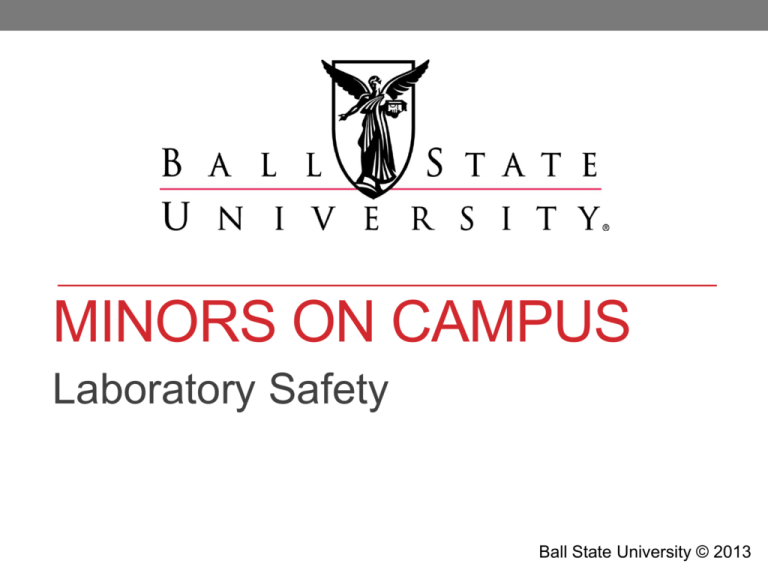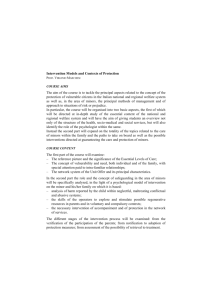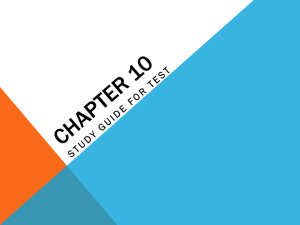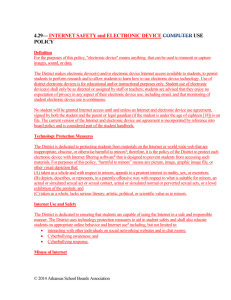Minors on Campus
advertisement

MINORS ON CAMPUS Laboratory Safety Ball State University © 2013 General Guidelines • Goal is to protect minors from potential harm, while teaching • • • • good laboratory practices. “Laboratory” means a science laboratory (research or teaching) wherein chemicals, solvents, etc. are used or stored. Computer or other laboratories are not included in this definition for training purposes. No person under the age of 16 may work in a laboratory under any circumstances. 16 and 17 year olds may work in most laboratories, but only under the DIRECT and CONSTANT supervision of an adult competent to evaluate the safety of the work being performed. This “Adult” should generally be a faculty member or senior staff member in the study area. Graduate assistants, aides, or volunteers may have limited supervisory responsibility delegated. Register all programs with the Director of Risk Management. ® Safety Equipment • Hands-free eye wash station • Safety shower • Fire blanket & fire extinguisher(s) • First-Aid Kit, including blood clean up items • Acid spill clean-up station • Broken glass disposal • Gloves, masks or goggles, chemical and flame-resistant lab coats or aprons • Telephone with an outside line in case of emergency • Natural gas, electricity hook-ups • Safety and chemical inventory ® Indiana Child Labor Laws • Minors are restricted by federal law from working in certain prohibited and hazardous occupations • Indiana Child Labor laws forbid the employment of minors in occupations deemed prohibited under the federal Fair Labor Standards Act (FLSA) or declared hazardous by the U.S. Secretary of Labor • Minors aged 14-15 may not work in any capacity in an occupation deemed hazardous • Minors aged 16-17 year olds may work in a limited capacity with supervision and safety measures in place ® Exposure to Radioactive Substances and Ionizing Radiations • Minors may not perform any work in any laboratory or workroom in which radium is stored or self-luminous compound is made, processed, packaged, stored, used, or worked upon. • They may not work in areas where incandescent mantles made from fabric and solutions containing thorium salts are manufactured, processed, or packaged. • They may not work in areas where other radioactive substances are present in the air in average concentrations exceeding 10% of the maximum permissible concentrations in the air recommended for occupational exposure by the National Committee on Radiation Protection. www.in.gov/dol “Prohibited and Hazardous Occupations for Minors” ® Controlled Substances • Indiana Code 35-48-2 lists schedules of controlled substances and drugs according to classification, including • Opiates • Opium derivatives • Hallucinogenic substances • Depressants • Stimulants • Narcotics • Under no circumstances should minors be permitted in any setting where research involving controlled substances is being performed. ® Hazardous chemicals & Explosives Some science experiments necessarily involve hazardous chemicals or explosives, but proper handling can make these reasonably safe for minors • Instruct participants in the proper handling of materials • Use only the designated tools and containers for materials, and ensure that they are properly labeled • Provide adequate supervision of all experiments ® Hazardous Chemicals & Explosives • Follow proper disposal requirements • Regularly check any natural gas or electricity outlets • Be prepared for accidents • Have safety measures in place; instruct students on what to do in the event of fire, emergency, or accidental exposure • Have emergency equipment (extinguishers, fire blankets, etc.) in a designated and easily accessible area • Minimize exposure with appropriate dress, safety equipment, and ventilation. If in doubt, see the OSHA Personal Protective Equipment Standard for guidance https://www.osha.gov/SLTC/personalprotectiveequipment ® Biological restrictions—microorganisms, blood & bodily fluids In addition to general safety procedures, specific safeguards should be utilized when minors come into contact with biological specimens, such as blood, bodily fluids, live cell cultures, or enzymes • Gloves should be worn when touching blood or body fluids, human or • • • • • animal tissue, mucous membranes, or microorganisms Masks and goggles should be worn during procedures likely to generate splashes of blood or body fluids into the mouth, nose or eye Lab coats or aprons should be worn Following the experiment, decontaminate the area with an appropriate disinfectant Dispose of any tissue or contaminated material appropriately Do not use samples of unknown origin; students should handle only their own personal samples ® Vivarium: Live plants & animals • Hand washing is the first line of defense against any disease; the most common method of contraction is to place infectious material directly in your own mouth, eyes, or nose • Address any allergies students may have; know the severity of any allergy and take necessary precautions relative to the risk ® Safety Procedures • Written consent from a parent or legal guardian may be advisable depending on the nature of the experiment(s). • Faculty or staff must provide appropriate safety training to minors prior to participation in a laboratory setting, including: • Hazards specific to the experiments or assignment • How to recognize those hazards and protect themselves • Laboratory-specific chemical hygiene plan • Standard operating procedures and emergency procedures • Personal Protective Equipment shall be utilized to minimize exposure to a variety of hazards, including lab coats, gloves, foot protection, eye protection (safety glasses or goggles), hearing protection (earplugs or muffs), hard hats, or respirators as applicable. ® Additional Resources • Center for Disease Control and Prevention: www.cdc.gov • Occupational Health & Safety Administration: www.osha.gov • Indiana Department of Labor: www.in.gov/dol • American Chemical Society: • www.acs.org • Health and Safety Resources for classroom science • Recommendations by grade level • National Association of Biology Teachers • www.nabt.org • Health & Safety Resources • Buying guides for live specimens • National Science Teachers Association • www.nsta.org ®




